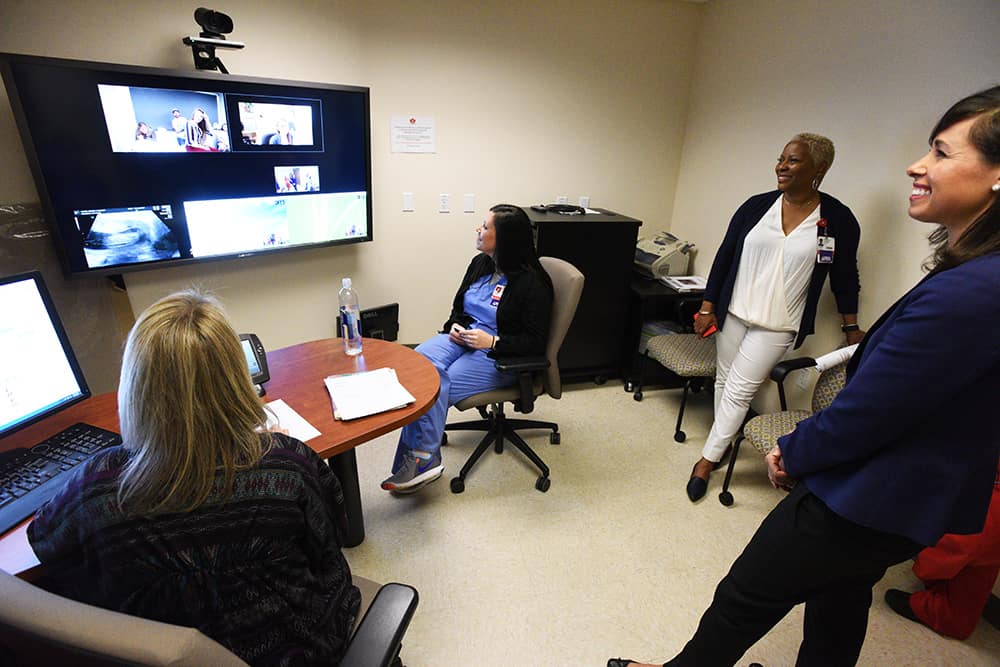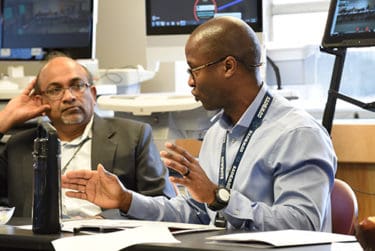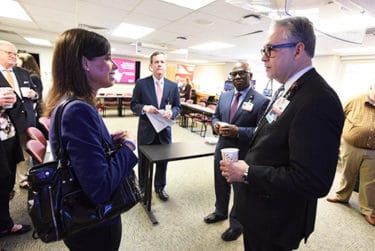FCC Commissioner Impressed by UAMS Digital Health Initiatives
| UAMS’ pioneering work in bringing health care to those who need it through digital health applications has drawn the attention of a top federal official who traveled from Washington D.C. to UAMS recently to see for herself.
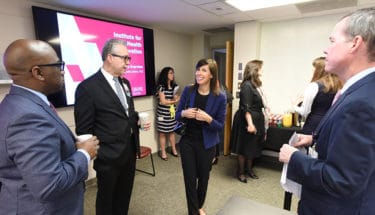
Maurice Rigsby, left, Curtis Lowery, Rosenworcel and Chancellor Cam Patterson talk at the start of the FCC commissioner’s recent tour of the UAMS Institute for Digital Health & Innovation.
Jessica Rosenworcel, a commissioner on the Federal Communications Commission, visited April 29 with UAMS Chancellor Cam Patterson, M.D., MBA; guests of the university; and leaders of UAMS’ new Institute for Digital Health & Innovation, including institute director Curtis Lowery, M.D.
“We are 46th out of 50 states in health outcomes,” Patterson said. “UAMS needs to change that for the better, and we won’t do it just by staying in Pulaski County.”
Telemedicine allows health professionals to diagnose and treat patients not physically present by using telecommunications technology, such as live video. It allows UAMS to extend its presence beyond its main campus and regional campuses.
The creation of the institute, under the leadership of Patterson and Lowery, was announced in February and builds upon several telemedicine programs already in place, including ANGELS for high-risk pregnancy, AR SAVES for stroke, STAR for rural School-Based Health Centers and more.
The institute connects the majority of hospitals and clinics across the state with telemedicine through interactive video and other digital services.
Lowery gave a brief presentation to Rosenworcel about the history of digital health and telemedicine at UAMS.
Lowery, Tina Benton, B.S.N., and a small team of clinicians and staff in 2003 founded ANGELS to bring maternal-fetal medicine to women with high-risk pregnancies who did not live near such a specialist.
ANGELS (the Antenatal and Neonatal Guidelines, Education and Learning System) is an innovative consultative service for a wide range of physicians including family practitioners, obstetricians, neonatologists and pediatricians in Arkansas.
An ANGELS obstetrician can talk to a pregnant mother via a live video connection and watch an ultrasound image of her baby from a local hospital so she can avoid traveling to Little Rock hours away. Lowery said the institute is doing a pilot study to see if ANGELS’ live video consultations can help during an emergency labor-and-delivery.
“That’s the only way you’re going to do anything about it,” Lowery said. “By the time you transfer a mother from that smaller hospital, we might lose her because of excessive bleeding. I think in the next year we’re going to explore the idea of delivering blood by using drones. It could make a real difference when a hospital doesn’t have the blood for a massive loss.”
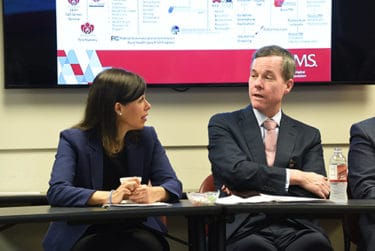
Rosenworcel, left, and Patterson, right, discuss digital health during a series of presentations about the subject.
Rosenworcel said she was intrigued by the idea of using drones to facilitate the transportation of blood and transplant organs.
During her visit, she observed a live ANGELS consultation with a pregnant mother in another Arkansas town and toured the 24-hour call center that routes calls for ANGELS and other telemedicine programs like Arkansas Stroke Assistance through Virtual Emergency Support (AR SAVES).
Renee Joiner, B.S.N., AR SAVES director, briefed Rosenworcel about the stroke telemedicine program.
UAMS started AR SAVES in 2008 to provide telemedicine consultations with stroke neurologists at any time via live video. Through this service, almost 2,000 patients have received a clot-busting drug that often restores complete function to the patient. Arkansas recently fell to seventh in the nation in the number of stroke deaths per capita after many years in first place, a huge improvement credited in part to the efforts of AR SAVES.
“I went down to Crossett on Friday and met a 27-year-old gentleman who had a stroke and went to the Ashley County Medical Center,” Patterson said. “He was treated through AR SAVES. Without this, he probably would have been a paraplegic and unable to work.”
Rosenworcel learned about the trauma telemedicine program and the School Telemedicine in Arkansas (STAR) program, the first-ever effort to bring telemedicine care to Arkansas’ rural School-Based Health Centers.
STAR two years ago rolled out the Healthy Now initiative for obesity reduction and prevention. Graduate students from the University of Central Arkansas and a UAMS nutritionist engage the students in one-on-one telemedicine encounters.
“We piloted the program in the Magazine School District,” said Alan Faulkner, a program manager for the institute. “With two groups of participating students, 51% in one group reduced their weight, and 66% in another group reduced their weight.”
Rosenworcel said she found those numbers to be very impressive.
She was also given an overview of the Arkansas e-Link network by network director Roy Kitchen. The network was created from a $102 million grant awarded in August 2010 to UAMS and partner institutions through the federal Broadband Technology Opportunities Program Comprehensive Community Infrastructure grant.
Led by UAMS, e-Link uses high-speed data transmission lines to connect about 400 community institutions for videoconferencing between medical professionals, patients and doctors and others along with the real-time exchange of patient data and readings.
“Your approach has been great,” Rosenworcel said. “Instead of building a network and then finding problems to solve with it, you identified many real problems in public health and specific ways a digital health network can be used to solve them.”
Rosenworcel especially enjoyed being able to meet an ANGELS patient via live video and observe the patient’s telemedicine consultation.
“We are becoming one of the most connected states in the nation, and we believe with that we can use digital health to improve the health and quality of life of Arkansans,” Lowery said.
